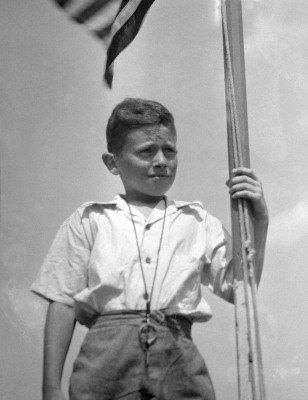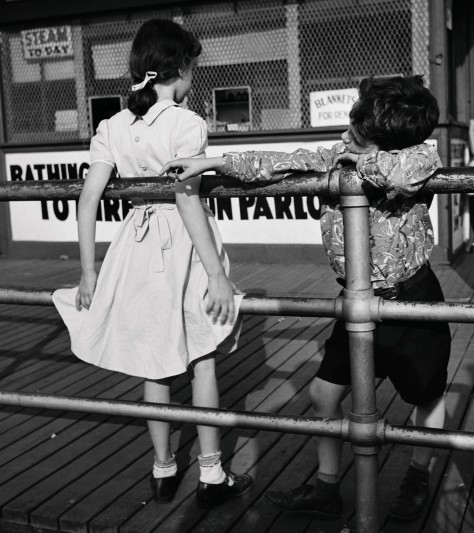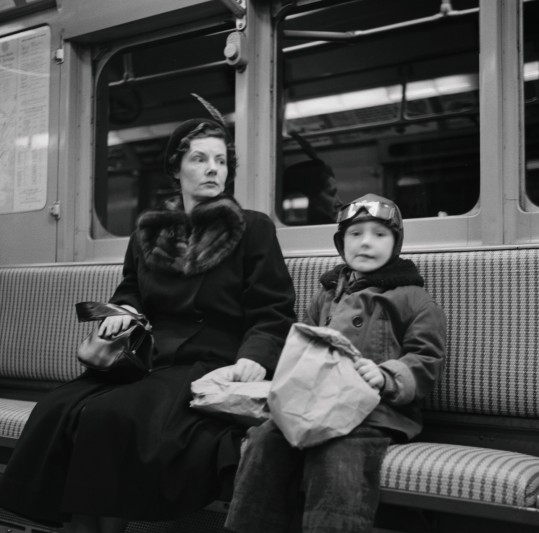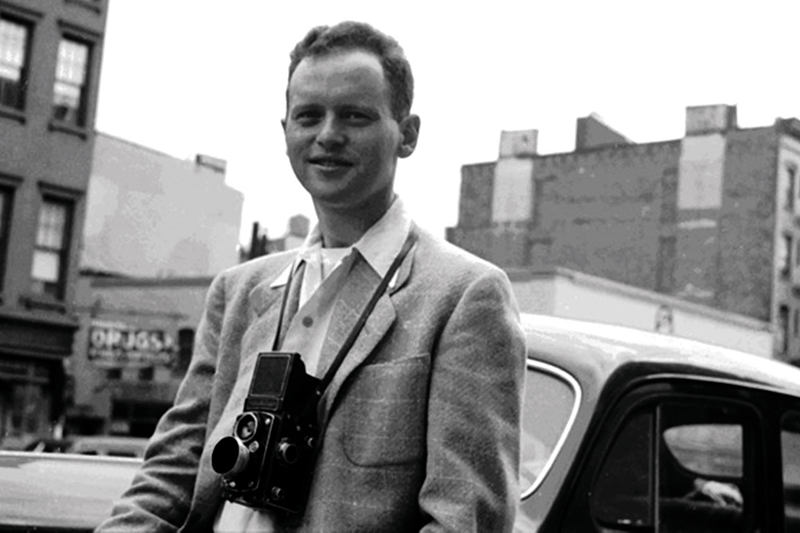In the spring of 2014, I stepped up to a podium in the Brown Auditorium Theater of The Museum of Fine Arts, Houston. The place was full and the audience attentive, expectant. They had just seen my documentary, “Martin Elkort: An American Mirror” about my father, and I was unsure if I could make it through my speech. I had long focused my professional life on people’s life histories, on creating something they could leave as a legacy for future generations of their families. I had finally decided to do the same for my family while my parents were still alive and in good health. The process took eight years.
I began to record my parents sometime in 2006. They sat side-by-side on the sofa in my home as I interviewed each in turn. But when I turned the camera on my father, more often than not, my mother interjected, correcting him, and then Dad deferred to her “recollection of events.” Worse, my mother had a long history of embellishing facts, which made it difficult to figure out what was the truth in what she said, and what was fantasy. Two years later, they came back to Houston to visit, and I tried to continue with them, but, this time, I was determined to get my father’s story in his voice.
I asked to interview Dad alone.
We covered many topics: general family history, what he knew of his parents and grandparents, his recollections of childhood, and his hospitalization with polio at fifteen. He talked about his early start as an artist and falling in love with photography.
To appease my mother, I did a few more interviews of her with my dad. It wasn’t apparent to me at the time, but looking back at the clips now, I see the signs of her impending dementia.
By then I had ten hours of video footage. I wasn’t sure what I was going to do with it all, but in my work, all too often I have raced against fading memories. I was well aware of the need to chronicle these stories while I still could. I was satisfied that I had captured some of our family histories, but the seed was planted for something more; I found my father’s story compelling, and important beyond our little family.
After his hospitalization with polio in 1944, Dad’s parents asked him what he wanted as a gift. He chose a single lens reflex camera. Costing more than a week of his father’s wages, this gift encouraged my father to get out and do something he enjoyed.

He took to walking the streets of New York City documenting the post-war boom. He loved to watch recent immigrants on the Lower East Side celebrate rebuilding their lives. Years later, reviews of his photography would point to the optimism of these photos during the post-depression period when it was easy to see only despair and decay.

Dad went on to study painting at the Cooper Union, but he ultimately decided photography was his medium and threw himself into its study. He joined the New York Photo League, an epicenter of the documentary movement in American photography, and there he found kindred souls. He met and studied under such masters as Sid Grossman, Aaron Siskind, Paul Strand and Imogen Cunningham. He also became an assistant to the in-house photographer Herman Brehmer at the prestigious Wildenstein Art Gallery.
By the time Dad met and married my mother in 1953, he had received critical acclaim in a number of photography magazines, and Edward Steichen, curator of photography for the New York MoMA, had purchased three of his photographs.
But as my parents settled into their marriage and began having children, it became apparent that he needed a job that was better suited to supporting a growing family. He took a job in advertising.
By the birth of their third child, his photographs had been relegated to boxes in the closet and his time combing New York streets for the perfect shot was a poignant memory.
When Dad turned seventy in 1999, my brother, sister, and I bought him a digital camera. That gift brought him back into the world of street photography. Then he discovered that his work from the late 1940s had been rediscovered and was in vogue. He went happily to work reprinting his old negatives. A lot unfolded from there. He had shows, gave talks. He sold many of his old photographs through galleries around the United States. This went on for a few years. In the midst of this renaissance, I began to video some of his presentations and shows.
But Dad enjoyed this revival for only a short time. After my parent’s visit to Houston in 2008, my mother’s dementia set in, and he was soon overwhelmed with caring for her and with the responsibilities she had managed for so many years.
I became their medical and financial liaison.
I began frequent trips to Los Angeles. Soon I decided, with my father’s permission, to take over management of his photography archives as well. There were boxes and boxes of prints, negatives, photographic supplies, stacks of magazines containing interviews with him, and lists of his inventory that was out with galleries. Together, we organized and cleaned and stacked. We created digital inventories. We took his more popular images, rescanned, and had new prints made.
Archiving all this work was a tedious process that took several years, but it was a gift of time we spent together. As we worked, we talked a lot about his photography. We also talked about his long absence from it, and what he still hoped to accomplish.
Dad was a child of immigrants, practical people, poor people, and he tended to be somewhat self-deprecating about the value of his talents. He viewed the renaissance of his work with a detached sense of wonder, almost as if he didn’t quite believe it was happening.
I began to see that I could help him document his legacy and realized that I wanted to do this for him. I wanted the whole world to know him and his work. More importantly, I wanted him to see the scope of what he had accomplished.
By 2011, my mother was completely dependent on Dad for day-to-day living. I flew to Los Angeles and had the inevitable conversation about moving her into a care facility, but he was reluctant. Then one day he fell at the local supermarket.
With some help, he was able to get up and resume shopping, but the experience rattled him. I told him I was sure that while he was lying there on that supermarket floor, the only thought going through his head was about what would happen to Mom if he had to go to the hospital.
That evening he told me he was ready to move them both. Within three weeks of what can only be described as a Herculean feat of planning, strategy, and sweat, I had them moved out of their condo and into a small apartment in the assisted living facility of his choice.
I found the seeds of my documentary in the mixed emotions of these changes in their lives and in what this meant for all of my family. I also had to acknowledge that although I had almost everything I needed to tell his story, the time to capture whatever was still missing was fleeting. Dad was changing.
I set about writing a script and pulling clips from that original footage. Honestly, the first cut was awful and fairly incoherent, but I’d found the line, or the arc as we call it in storytelling. From start to completion, it took almost three years until I was happy and ready to show the work.

During this process, I showed it to many people, gauged their reactions, and integrated their incredible input into my edits. Finally my good friends Bruce and Carol, who had a combined hundred or so years in the entertainment industry, gave me the coup de gras: they said the only thing missing was Dad talking about his photos. Brilliant. I went back to Los Angeles and recorded Dad talking about several of his favorite most iconic photographs, about his technique and the narrative behind the shot, and we peppered these throughout the documentary. It was wonderful.
There were compromises. I had recorded the 2008 interviews on an old standard definition camcorder, and the quality wasn’t up to par with the high definition footage I took later. But, those early interviews were so authentic and unrehearsed (and besides, we had passed a point where dad was comfortable re-recording them) so I kept them in.
While all of this was going on, dad remained very involved in discussions and fact checking. He was excited about seeing the outcome.
Then came the day in 2014 when we viewed the finished video as a family.
We watched it in his little living room—me and Dad, my brother and sister, along with a few close friends. When the final credits rolled on, I looked back to the group expectantly.
Then Dad turned to me with great happiness and said, “Who was that guy in the video? Was it me?” It was probably one of the best moments of my life.
This is the great privilege of my work, one that feeds me intensely and why I continue to do it—getting to be there at that moment when a client is fully present to all they have accomplished and everyone they’ve touched in their lives. I love to watch them as they watch their lives displayed and vivid before them. That first screening is magical. I got to see my dad have that. I watched our family and close friends, imagining how they can now understand him in a fuller context.
By the spring of 2014, Mom was pretty incapacitated, and Dad was unwilling to travel without her, but he was very much with me in spirit when I delivered my speech at the MFA Houston about what this film had meant for us.
“Martin Elkort: An American Mirror” has also screened in several other venues, including the Los Angeles Center of Photography. He was able to attend that one. Many of his peers and photographers he once mentored came to show their love and support.
Mom and Dad both continue their slow decline.
Dad is now in a wheelchair; the childhood polio caused so much muscle damage that walking now is too difficult.
I often express my gratitude to him. The process of creating a documentary of his life brought it home to me what he sacrificed for us children long ago when he put down his camera and went off to work in advertising.
I am who I am because of that sacrifice, and yet ironically, at some level, his art must have drawn me to my life behind the camera.
Over the past year, Dad and I have been working on his first photography book, entitled “Children: Behind The Lens,” a volume of his photographs of children from the 40s through the early 2000s.
Last week, I sent him a full bound proof. After I had known he’d had time to be really with the book, I called and asked him what he thought.
He said, “I love it. And I love you. You always remind me of who I am.”
Both projects are now available to view and purchase via the links below:
Watch the documentary online: “Martin Elkort: An American Mirror.”
The book is available for purchase: Children Behind the Lens
Stefani Twyford
President and Founder of Legacy Multimedia, Stefani Twyford has more than 18 years experience designing, developing and implementing award-winning video biographies and tribute videos. Prior to starting Legacy Multimedia, she built and headed a successful Houston-based web design, e-commerce and marketing firm. With degrees in design, psychology and social work, Twyford also shares her knowledge about the importance and process of creating a meaningful legacy with her engaging presentations to various organizations. Twyford excels at helping people craft their stories and share their memories. Her commitment to high-quality work and customer service, and her gift for putting people at ease help her clients capture their stories in a way that will endure for generations. Her firm commitment to the arts, to the technology community and to women in business has helped many others and served as inspiration for the next generation of talented professionals. In 2012 she turned the lens on her own family and her father’s profile as a known street photographer. Her documentary “Martin Elkort: An American Mirror” screened mid 2014 at the Museum of Fine Arts, Houston followed by other screenings around the US and has won a 2014 Gold Remi Award for Best Documentary from Worldfest International Film Festival.

Thanks so much for your kind words Stephanie. It was such a beautiful time for us, working on these projects.
Martin Elkort’s photographs captured human interaction by chronicling such candid moments on the streets. There is such a nostalgic tone of what America was during the post-war period and Martin captured these moments beautifully. But this story is about the unconditional bond between a father and her devoted daughter. Your commitment Stefani to preserve your father’s legacy it’s admirable. I love how expressed his gratitude towards you, what a humble man.
Thank you, Stefani, for sharing such personal moments with your family to us. I can see why your father is so proud of you.
Cheers!
I’m so glad to hear you had this great experience with your grandfather. The time I spend with families helping them create histories to pass on has been some of the most valuable experiences in my life. Knowing that family members finally get present to who their relatives are and what they’ve done with their lives is a privilege to witness. Glad to hear you were able to help him so much. I know that it meant a lot to him to share that experience with you.
I loved this for so many reasons. I related in a way because I spent so much time with my grandfather as he cared for my grandmother who had Alzheimer’s. I loved the hours I spent with him, helping him with his books of family history he prepared for his grandchildren — so much more less involved than what you write about here but so important to him. He would photocopy old photographs, cut them out and gluestick them into place and then photocopy all the pages. He sacrificed his teaching career for my grandmother, retiring early and so not having the retirement pension he should have earned.
Thank you for sharing this with us.
Thanks so much Mary. I appreciate your comments and hope you’ll take the time to watch the documentary.
Beautiful story, Stephanie. What a lovely way to pay tribute to your dad and also spend precious time together. I hope to see your film some time.